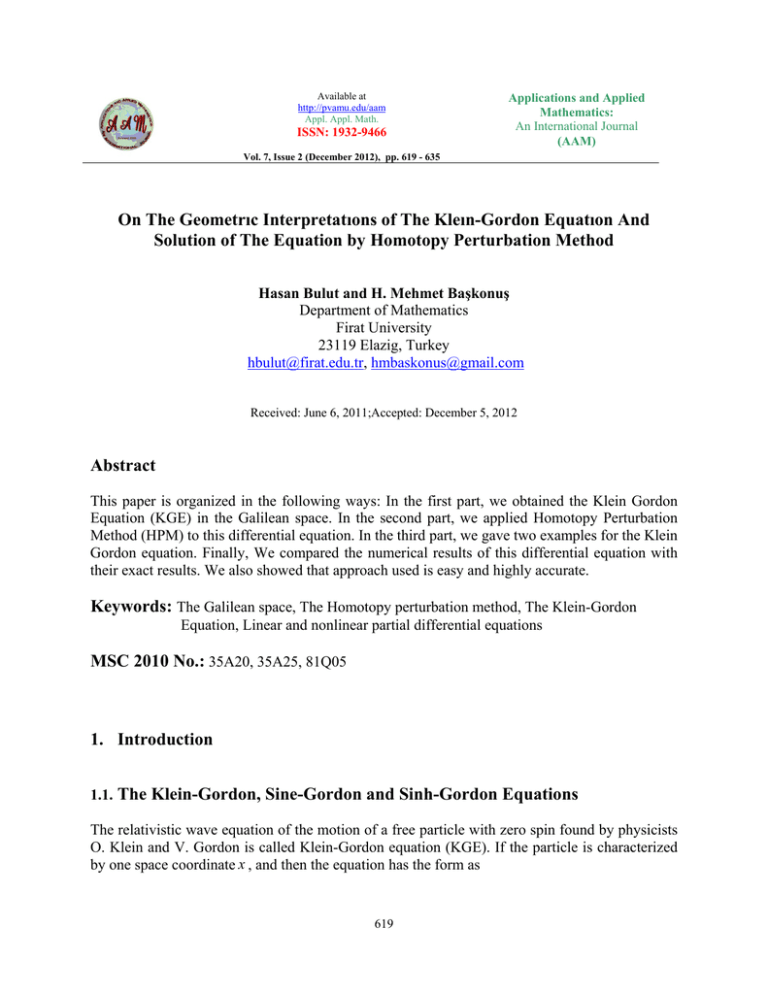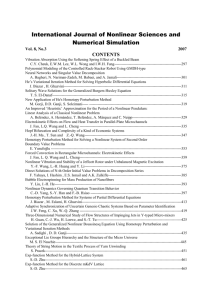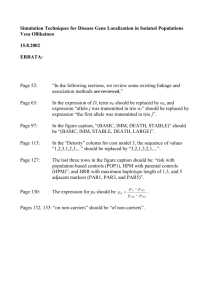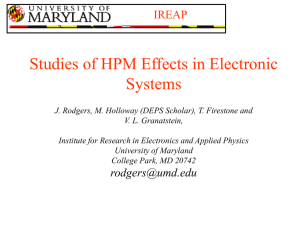Document 12062163
advertisement

Available at http://pvamu.edu/aam Appl. Appl. Math. ISSN: 1932-9466 Applications and Applied Mathematics: An International Journal (AAM) Vol. 7, Issue 2 (December 2012), pp. 619 - 635 On The Geometrıc Interpretatıons of The Kleın-Gordon Equatıon And Solution of The Equation by Homotopy Perturbation Method Hasan Bulut and H. Mehmet Başkonuş Department of Mathematics Firat University 23119 Elazig, Turkey hbulut@firat.edu.tr, hmbaskonus@gmail.com Received: June 6, 2011;Accepted: December 5, 2012 Abstract This paper is organized in the following ways: In the first part, we obtained the Klein Gordon Equation (KGE) in the Galilean space. In the second part, we applied Homotopy Perturbation Method (HPM) to this differential equation. In the third part, we gave two examples for the Klein Gordon equation. Finally, We compared the numerical results of this differential equation with their exact results. We also showed that approach used is easy and highly accurate. Keywords: The Galilean space, The Homotopy perturbation method, The Klein-Gordon Equation, Linear and nonlinear partial differential equations MSC 2010 No.: 35A20, 35A25, 81Q05 1. Introduction 1.1. The Klein-Gordon, Sine-Gordon and Sinh-Gordon Equations The relativistic wave equation of the motion of a free particle with zero spin found by physicists O. Klein and V. Gordon is called Klein-Gordon equation (KGE). If the particle is characterized by one space coordinate x , and then the equation has the form as 619 620 H. Bulut and H. M. Başkonuş (1.1) utt u xx m 2u . where t is time, u u t , x is wave function, and m is the mass of the particle. Note that Equation (1.1) for m 0 is a classical one-dimensional wave equation (the equation of a vibrating string) whose solution u t , x has the form f x t f x t , where f t is an arbitrary function. By analogy with KGE the equations u tt u xx sin u (1.2) u tt u xx sinh u (1.3) are called Sine-Gordon equations (SGE) and Sinh-Gordon equation (SHGE), respectively. Equation (1.2) has also an important physical meaning: since the left-hand side of this equation coincides with the left-hand side of the equation of a vibrating string of the wave [Inc and Ugurlu (2007)] Equation (1.1), it is also a wave equation, but, unlike Equation (1.1), it is nonlinear (Liao, He (2003, 2004, 2006, 2007, Bektas et al. (2004)) and describes physical processes related to the nonlinear [Adomian (1986)] waves, in particular solitary waves (solitons) [Drazin(1989)] which preserve their shape under interaction. This theory is very important for the theory of plasm. The n-dimensional Galilean and pseudo-Galilean spaces n and 1n can be defined as the affine space E n whose hyperplane at infinity is endowed by the geometry of the Euclidean space Rosenfeld (1969) R n 1 or the pseudo – Euclidean space R1n 1 [see, Rosenfeld (1969) pp. 295297]. If a system of affine coordinates in the space E n is chosen such that the basis vectors e2 , e3 , , en are directed to the hyperplane at infinity of R n 1 or R1n 1 , the distance d between two points X x1 , x 2 , , x n and Y y1 , y 2 , , y n is equal to y 1 x1 . If x1 y 1 , when d 0 , then these points have another distance d 1 equal to the distance between the points X 1 x 2 , x3 , , x n and Y 1 y 2 , y 3 , , y n in R n 1 or R1n 1 , respectively. The motions in n and 1n have the form x x1 a1 , 1 1 x AIi x1 Aij x i a i 1 i i, j 2,3, , n , where A ij is an orthogonal or pseudo–orthogonal n 1 n 1 – matrix, respectively (here the Einstein rule for summation is used). These formulas coincide with the formulas of transformation of orthogonal coordinates in the n-dimensional isotropic or pseudo isotropic spaces I n or I In , respectively, I n is the n-dimensional affine space E n whose hyperplane at infinity is endowed with the geometry of the co-Euclidean space R n I * or the copseudoEuclidean space RIn I * corresponding to R n I and R In I in the duality principle of the projective space P n I . The motions in I n and I In have the from AAM: Intern. J., Vol. 7, Issue 2 (December 2012) x x1 Ai1 x i a1 , 1 1 i 621 x i Aij x j a i , i, j 2,3, , n . The hyperplane at infinity of R n 1 and RIn 1 , that is, the n 2 plane x1 0 in the hyperplane x 0 0 , and the absolute imaginary or real hyperquadric in this n 2 -plane, which is the intersection of all hyperspheres in R n 1 or RIn 1 , form the absolutes of n and 1n . For 3 and 13 the absolutes consist of the plane at infinity, line x1 0 , and two imaginary conjugate or real points on this line. Depending on a position relative to the absolute of For 3 and 13 the lines and planes in these spaces are divided into two classes: lines of general position which do not meet the line x1 0 , and special lines which meet the line: planes of general position which 2 do not contain the line x1 0 (the planes 2 or 1 ),and special planes which contain this line (the planes R 2 or R12 ). At each point X in 3 or 13 we determine orthonormal frames which consist of vectors e1 , e2 , e3 of length 1 or i such that the line Xe1 is a line of general position, and the lines Xe2 , Xe3 are special lines which divide harmonically the lines joining X with two imaginary conjugate or real points of the absolute whose equations will be written as 2 3 g 22 x 2 g33 x 3 0 , where g 22 g 33 1 for 3 and g 22 g 33 1 for 13 . If a point X is characterized by a position vector x, then the derivation formulas for these frames are dx i ei , de1 1 eu , u where i, j 1,2,3, u 2,3, equations gives de2 2 e3 , 3 de3 3 e2 , 2 32 23 , 1 for 3 and 1 for 13 . Exterior differentiation of these d I 0, d u i iu , d1u 1v vu , d 23 0 . , (1.4) where v 2,3 . Formulas (1.4) show that the linear forms 1 and 23 are locally exact differentials, therefore 1 du, 23 dv. (1.5) Consider a curve C of general position in 3 or 13 . If X is a point on this curve, e1 is tangent vector to this curve at X, e2 is a special vector of the oscillating plane of this curve at X, and e3 is the third vector of an orthonormal frame. The derivation equations of this curve are 622 H. Bulut and H. M. Başkonuş dx e1 , dt de1 ke2 , dt de2 e3 , dt de3 e2 , dt (1.6) where t is the natural parameter He (2001), k and are the curvature and the torsion of the curve. Consider a surface S of general position in 3 or 13 . Let us suppose that the intersections of this surfaces with Euclidean or pseudo-Euclidean planes x1 const. are not straight lines, that is, this surface has no special rectilinear generators. We determine at a point X of this surface the orthonormal frame, whose vectors e1 and e2 are tangent vectors to S at X and e3 is the normal vector to S at X , that is, this vector is orthogonal to e2 (the vectors e2 and e3 of this are in a plane x1 = 0). The differential equation of Pfaff of the surface S is 3 0 . (1.7) The exterior differentiation of the equation gives 1 13 2 23 0, (1.8) hence, by means of the Cartan lemma, we obtain 31 a 1 b 2 , 23 b 1 c 2 . (1.9) The first fundamental forms of the surface S for general curves are 2 I ds 2 1 , (1.10) and for special curves are I 1 ds I g 22 2 2 2 , (1.11) that is, intersections of S, with planes x 1 . The second fundamental form of the surface S is 2 2 II d 2 a, e3 g33 113 223 g 22 a 1 2b1 2 c 2 . (1.12) We call a surface in 13 spacelike if g 22 1 and timelike if g 22 1 . The line of the absolute determines on the surface S, the Koenigs net consisting of special curves which are intersections of S with the planes x I 0 , and of curves of tangency of cones with apices on the line of the AAM: Intern. J., Vol. 7, Issue 2 (December 2012) 623 absolute tangent to S. The curves of this net are curvature lines of S, since normal lines to S along curves of this net forms developable surface. At the points of the curvature lines of S of general position, vectors e2 of moving frames have constant directions, since they are directed to the apices of cones, therefore for curvature curves of general position, 23 0 . It follows from (1.5), that the equations of curvature curves of S are u const. v const . The coordinates u and v are called canonical coordinates on the surface S. The principal curvatures of S, that is normal curvatures k n II / I for curves 1 0 and 23 0 are, respectively, k1 c, k2 g33 ac b 2 . c (1.13) Hence, the Gaussian curvature K = Ke = k1 k2 of the surface S is K k1 k 2 g 33 ac b 2 . (1.14) Therefore, the Gaussian curvature of a surface S in 3 and of a timelike surface in 13 is equal to ac b 2 and of a spacelike surface in 13 is equal to b 2 ac . Note that the condition for the surfaces S in 3 and 13 which have no special rectilinear generators is the equality c = 0. The curves on a surface S which are determined by the equation II = 0 are asymptotic curves. Since the form II is expressed by the formula (1.12), the condition for finding asymptotic directions = 2/ 1 of general position is a 2b c 2 0 . (1.15) In the case when vector e1 of the moving frame is fixed at every point A on S, the moving frame is canonical and all other forms are principal, that is 12 a1 2 . (1.16) The exterior differentiation of the forms (1.9) and (1.16) and the substitution of expression (1.7), (1.16), (1.14) and (1.16) into (1.4) give - 2 1 g33 K , (1.17) - a 2 2b b1 ca 0 , (1.18) - b2 c1 c 0 , (1.19) 624 H. Bulut and H. M. Başkonuş where the indices p1 and p2 mean Pfaffian derivatives determined by the formula dp p I I p 2 2 . Let the vector e1 e1 be tangent to a curvature curve of general position, that is, the coordinate system on the surface S is canonical system u, v, and let us find the corresponding differential forms of the moving frame. Since the curvature of a special curvature curve is k1 dv ds1 , where v is on angle between tangent lines and s1 is the length of special curve then formulas (1.11) and (1.13) imply that dv cw2 . Let us denote the radius of curvature of this curve by k11 c 1 (1.20) then we have 2 dv . (1.21) By the substitution (1.21) into the second formula (1.16) and by formulas (1.5) and a 0 , we obtain b 0. (1.22) Therefore, the formulas (1.13) have the from k1 c, k 2 g 33 a . (1.23) By formulas (1.5) and (1.21) we can express the Pfaffian derivatives p1 and p2 through the partial derivates p u and p v in the form p1 pu , p2 cpv . Therefore, by the equations (1.18), (1.19) and (1.22) we obtain cu u , av , that is, 12 av 1 u 1 2 av du u dv. In this case formula (1.17) can be written as avv uu a . (1.24) This formula shows that the conditions of integrability of the differential equations of a surface S are reduced to single differential equation for its principal curvatures k1 and k 2 . AAM: Intern. J., Vol. 7, Issue 2 (December 2012) 625 Let a surface S have a curvature K const = m 2 where 1. When a surface S is referred to the canonical coordinates, let us show that the equation (1.24) can be reduced to the form (1.1). In this case formulas (1.23) can be written as k1 c 1 , k 2 Kk11 m 2 and also formula (1.24) can be written as g 33m 2 vv uu g33m 2 . (1.25) Let us set 1 for a surface in 3 and for a spacelike surface in 13 ; then we obtain uu m 2 vv m 2 , that is, if we denote u by t, v / m by x, the function by u for m = 1 , we obtain an equation utt u xx u . 2. An Analysis of the HPM A lot of methods have been used to obtain solutions of partial differential equations in the literature [He and Elagan (2011)]. We consider HPM which is one of the most used methods. The first of all, we must obtain form HMP [Abbasbandy (2006), He (1999)] for HPM. To illustrate the basic ideas of this method, we consider the following equation: Au f r 0, r , (2.1) with boundary condition u B u, 0, r , n (2.2) where A is a general differential operator, B a boundary operator, f (r) a known analytical function and Γ is the boundary of the domain Ω. A can be divided into two parts which are L and N, where L is linear and N is nonlinear. Equation (2.1) can therefore be rewritten as follows; L u N u f r 0 , r . Homotopy perturbation structure is shown as following; (2.3) 626 H. Bulut and H. M. Başkonuş v, p 1 p L v L u0 p A v f r 0, (2.4) where vr , p : 0,1 . (2.5) In Equation (2.4), p [0, 1] is an embedding parameter and u0 is the first approximation that satisfies the boundary condition. We can assume that the solution of Equation (2.4) can be written as a power series in p, as following; v v0 pv1 p 2 v2 p 3v3 , (2.6) and the best approximation for solution is u lim v v0 v1 v2 v3 , p 1 (2.7) The convergence of series Equation (2.7) has been proved by He (2000). This technique can have full advantage of the traditional perturbation techniques. The series Equation (2.7) is convergent rate depends on the non-linear operator A(v) (the following opinions are suggested by He (2000): (1) The second derivative of N (v) with respect to v must be small because the parameter may be relatively largee, i.e., p 1 . (2) The norm of L1 (N / v) must be smaller than one so that the series converges. 3. Applications of The HPM Example 1. We consider a linear partial differential equation in order to illustrate the technique discussed above. The problem of the form is utt u xx u , (3.1) where exact solution of the differential Equation (3.1) is given by; u ( x, t ) ( x 1) sin t and initial conditions (3.2) AAM: Intern. J., Vol. 7, Issue 2 (December 2012) 627 ut ( x, 0) x 1. Structure of HPM He (2004, 2003, 2001, 2009) for Equation (3.1) is 1 p [Y u0 ] p Y Y '' Y 0 , .. .. .. .. .. .. .. (3.3) .. Y u0 pY p u0 pY pY '' pY 0 , .. .. .. Y u0 p u0 pY '' pY 0 , (3.4) 2 y 2 y " , Y and p 0,1 . We suppose that the solution of Equation (3.1) has the t 2 x 2 form as following; .. where Y Y Y0 pY1 p 2Y2 p 3Y3 p nYn x, t (3.5) n 0 .. .. .. .. .. Y Y 0 pY 1 p 2 Y 2 p 3 Y 3 , Y " Y0" pY1" p 2Y2" p 3Y3" . Then, substituting Equation (3.5) into Equation (3.4), and rearranging based on powers of p terms, we obtain: .. .. .. .. .. .. 2 3 " " 2 " 3 " 2 3 Y pY p Y p Y u pu 0 1 2 3 0 0 p Y0 pY1 p Y2 p Y3 p Y0 pY1 p Y2 p Y3 0 , .. .. .. .. .. .. Y 0 pY 1 p2 Y 2 p3 Y 3 u0 pu0 pY0" p2Y1" p3Y2" pY0 p 2Y1 p3Y2 0 , .. .. p 0 : Y 0 u0 0 .. .. p1 :Y 1 u0 Y0" Y0 0 .. p 2 :Y 2 Y1" Y1 0 .. p 3 : Y 3 Y2" Y2 0 (3.6) (3.7) (3.8) (3.9) with solving Equation (3.6- 3.9); .. .. p 0 : Y 0 u0 0 Y0 u0 ( x, 0) x 1, (3.10) 628 H. Bulut and H. M. Başkonuş .. .. .. .. p1 : Y1u0 Y0" Y0 0 Y1 u0 Y0" Y0 t t .. Y1 u0 Y0" Y0 dt dt 00 1 Y1 t3 x 1 , 6 .. .. p 2 : Y 2 Y1" Y1 0 Y 2 Y1" Y1 t t Y2 Y1" Y1 dt dt (3.11) 0 0 Y2 .. 1 5 t x 1 , 5! .. p 3 : Y 3 Y2" Y2 0 Y 3 Y2" Y2 t t Y3 Y2" Y2 dt dt (3.12) 0 0 Y3 1 7 t ( x 1), 7! the terms of Equation (3.5) could easily calculated. When we consider the series Equation (3.5) with the terms Equations (3.6-3.9) and suppose p 1 , we obtain approximation solution of Equation (3.1) as following; u x, t Y0 Y1 Y2 Y3 . (3.13) As a result, the components Y0 , Y1 , Y2 , Y3 , are identified. We obtain analytic solution of Equation (3.1) as following; 1 1 5 1 7 u x, t t x 1 t 3 x 1 t x 1 t ( x 1) 6 120 5040 t3 t5 t7 u x, t x 1 t 3! 5! 7! AAM: Intern. J., Vol. 7, Issue 2 (December 2012) 2 1.75 u1.5 1.25 1 629 2 1.8 1.6 0 0.2 1.4 0.4 x 2 1.75 u1.5 1.25 1 2 1.8 1.6 0 t 0.2 0.4 1.2 0.6 0.8 1 1.4 x 1.2 0.6 1 0.8 1 a. Exact Solution t 1 b. Approximation Solution HPM Figure 1. The 3D surfaces for Y3 in comparison with the analytic solution u ( x, t ) when t = 0.05 with initial condition of Equation (3.1) by means of HPM 0.1 0.1 0.09 0.09 0.08 0.08 0.07 0.07 0.06 0.06 0.05 0.05 0 0.2 Exact Sol . 0.4 0.6 a. Exact Solution 0.8 1 0 0.2 App . Hpm 0.4 0.6 0.8 1 b. Approximation Solution HPM Figure 2. The 2D plots of the numerical results for Y3 in comparison with the analytic solution u ( x, t ) when t = 0.05 with initial condition of Equation (3.1) by means of HPM Example 2. We consider a nonlinear partial differential equation given as utt u xx u 2 uu x 0, 0 x 1 , t 0. (3.14) The boundary conditions and initial condition are u ( x, 0) ut ( x, 0) e x , 0 x 1, u (0, t ) et , (t 0). Structure of HPM He (2004, 2003, 2001, 2009) for Equation (3.1) is (3.15) 630 H. Bulut and H. M. Başkonuş 1 p [Y u0 ] p Y Y '' Y 2 YY ' 0, .. .. .. .. .. .. .. .. .. .. (3.16) .. Y u0 pY p u0 pY pY '' pY 2 pYY ' 0, Y u0 p u0 pY '' pY 2 pYY ' 0 , (3.17) 2 y 2 y y " Y , , Y ' , and p 0,1 . We suppose that the solution of Equation 2 2 t x x (3.14) has the form as following; .. where Y Y Y0 pY1 p 2Y2 p 3Y3 p nYn x, t , (3.18) n 0 .. .. .. .. .. Y Y 0 pY 1 p 2 Y 2 p 3 Y 3 , Y " Y0" pY1" p 2Y2" p 3Y3" , (3.19) Y ' Y0' pY1' p 2Y2' p 3Y3' . Then, substituting Equation (3.19) into Equation (3.17), and rearranging based on powers of p terms, we obtain; .. .. p 0 : Y 0 u0 0 , .. (3.20) .. p1 :Y 1 u0 Y0" Y0Y0' Y02 0 , (3.21) .. p 2 :Y 2 Y1" Y1'Y0 Y0'Y1 2Y0 Y1 0 , .. p 3 : Y 3 Y2" Y2'Y0 Y1'Y1 Y12 Y0'Y2 2Y0 Y2 0 , (3.22) (3.23) with solving Equation (3.20-3.23); .. .. p 0 : Y 0 u0 0 Y0 u0 Y0 ut ( x, 0) e x (t 1), .. .. .. .. ' 2 " ' 2 p1 :Y1u0 Y0" YY 0 0 Y0 0 Y1 u0 Y0 YY 0 0 Y0 , t t .. ' 2 Y1 u0 Y0" YY 0 0 Y0 dt dt , 00 t t ' 2 Y1 Y0" YY 0 0 Y0 dt dt , 00 t 2 t3 Y1 e , 2! 3! x (3.24) AAM: Intern. J., Vol. 7, Issue 2 (December 2012) 631 .. p 2 :Y 2 Y1" Y1'Y0 Y0'Y1 2Y0 Y1 0 , .. Y 2 Y1" Y1'Y0 Y0'Y1 2Y0 Y1 , t t (3.25) Y2 Y1" Y1'Y0 Y0'Y1 2Y0 Y1 dt dt , 0 0 t 4 t5 Y2 e x , 4! 5! .. p 3 : Y 3 Y2" Y2'Y0 Y1'Y1 Y12 Y0'Y2 2Y0 Y2 0 , .. Y 3 Y2" Y2'Y0 Y1'Y1 Y12 Y0'Y2 2Y0 Y2 , t t (3.26) Y3 Y2" Y2'Y0 Y1'Y1 Y12 Y0'Y2 2Y0 Y2 dt dt , 0 0 t6 t7 Y3 e , 6! 7! x the terms of Equation (3.18) could calculated. When we consider the series Equation (3.18) with the terms Equation (3.24)- Equation (3.26) and suppose p 1 , we obtain approximation solution of Equation (3.14) as following; u x, t Y0 Y1 Y2 Y3 (3.27) As a result, the components Y0, Y1, Y2, Y3 , are identified. We obtain analytic solution of Equation (3.14) t2 t3 t4 t5 t6 t7 u x, t e x 1 t . 2! 3! 4! 5! 6! 7! 20 15 u 10 5 0 0 2 1.8 1.6 1.4 0.2 0.4 x 1.2 0.6 0.8 a: Exact Solution 11 0.05 20 15 u 10 5 0 0 2 1.8 1.6 1.4 0.2 0.4 x 0.05 1.2 0.6 0.8 11 b: Approximation Solution HPM Figure 3. The 3D surfaces for Y3 in comparison with the analytic solution u ( x, t ) when t = 0.05 with initial condition of Equation (3.14) by means of HPM 632 H. Bulut and H. M. Başkonuş Table. 1 Absolute errors obtain for Example.1. The numerical results for Y3 in comparison with the analytic solution u ( x, t ) when x 0.1 with initial condition of Equation (3.1) by means of HPM, ADM, VIM t u Exact u Hpm x 0.1 uExact uVim uExact u Adm 0.1 1,3877800E–17 -0,329633 1,3877800E–17 0.2 -5,551120E–17 -0,657070 -5,551120E–17 0.3 0 -0,980122 0 0.4 1,2221250E–14 -1,296630 1,2221250E–14 0.5 2,1538300E–14 -1,604450 2,1538300E–14 2.75 2.75 2.5 2.5 2.25 2.25 2 2 1.75 1.75 1.5 1.5 1.25 1.25 0 0.2 Exact Sol . 0.4 0.6 0.8 0 0.2 Appr . Hpm 1 a. Exact Solution 0.4 0.6 0.8 1 b. Approximation Solution HPM Figure 4. The 2D plots for Y3 in comparison with the analytic solution u ( x, t ) when t =0.05 with initial condition of Equation (3.14) by means of HPM Table 2. Absolute errors obtain for Example. 2. The numerical results for Y3 in comparison with the analytic solution u ( x, t ) when x 0.1 with initial condition of Eq.(3.14) by means of HPM, ADM, VIM x 0.1 t 0.1 0.2 0.3 0.4 0.5 u Exact u Hpm 2,77112E–13 7,17608E–11 1,86016E–09 1,87949E–08 1,13330E–07 uExact uVim 9,36547E–8 3,04824E–6 2,35485E–5 1,00973E–4 3,13615E–4 uExact u Adm 2,77112E–13 7,17608E–11 1,86016E–09 1,87949E–08 1,13330E–07 AAM: Intern. J., Vol. 7, Issue 2 (December 2012) 633 4. Numerical Comparison Tables 1 and 2 show the difference of analytical solution and numerical solution of the absolute error. We also demonstrate the numerical solution of Equation (3.1) in Figure 1(a), the corresponding approximate numerical solution in Figure 1(b) and Equation (3.14) in Figure 2(a), the corresponding approximate numerical solution in Figure 2(b). We note that only 3 terms were used in evaluating the approximate solution. We achieved a very good approximation with the actual solution of the equations by using 3 terms only of the Homotopy perturbation method above. It is evident that the overall errors can be made smaller by adding new terms to the perturbation. Numerical approximations shows a high degree of accuracy and in most cases n, the n-term approximation, is accurate for quite low values of n. The solution is very rapidly convergent by utilizing the homotopy perturbation method. We obtained that the true of this methodology justify from this numerical results, even in the few terms approximation is accurate. 2 1.75 u1.5 1.25 1 2 1.8 2 1.75 u1.5 1.25 1 1.6 0 0.2 0.4 x 0.8 0.4 (b) Numerical Solution (HPM) 2 1.75 u 1.5 1.25 1 2 1.8 1.6 0 0.4 x 2 1.8 1.6 1.4 0.4 u 8 2 6 1 1.8 4 0.5 1.6 0 1.4 0.2 0.4 1.2 0.6 1 (b) Numerical Solution (ADM) 2 1.75 u 1.5 1.25 1 0.8 0.8 1 0 t 1.2 0.6 1 (a) Exact Solution 0.1 1.6 1.4 0.2 1.2 1 0.2 2 1.8 0 t 1.4 0.2 0.6 1 1 2 1.75 u 1.5 1.25 1 0.8 0.8 1 0.4 1.2 0.6 x (a) Exact Solution t 1.4 0.2 1.2 0.6 1 x 1.6 0 t 1.4 2 1.8 x 1 1.2 0.6 0.8 1 (a) Exact Solution 1 b) Numerical Solution (VIM) Figures A t 634 H. Bulut and H. M. Başkonuş 20 20 u 15 10 5 0 0 u 2 1.8 1.6 t 1.4 0.2 0.4 2 1.8 1.6 0.8 1 0.4 x 1.2 0.6 0.8 1 1 (a) Exact Solution t 1.4 0.2 1.2 0.6 x 15 10 5 0 0 1 (b) Numerical Solution (HPM) 20 20 15 u 10 5 0 0 2 u 1.8 1.6 0.2 1.4 0.4 2 1.8 1.6 0.8 1 0.4 x 1.2 0.6 0.8 1 1 (a) Exact Solution t 1.4 0.2 1.2 0.6 x t 15 10 5 0 0 1 (b) Numerical Solution (ADM) 20 u 15 10 5 0 0 2 1.8 1.6 0.2 1.4 0.4 x t 15 u 10 5 0 0 1.6 1.4 0.2 0.4 1.2 0.6 2 1.8 x 0.8 1 1 1.2 0.6 0.8 1 (a) Exact Solution t 1 (b) Numerical Solution (VIM) Figures B 5. Conclusion The method have been used for solving a lot of differential equations such as ordinary, partial, linear, nonlinear, homogeneous, nonhomogeneous by many researchers. In this research, we used for solving linear and nonlinear Klein-Gordon equations with initial conditions. According to these datas such as 3D, 2D graphics and Tables, one realize that one of the advantages of HPM displays a fast convergence of the solutions. AAM: Intern. J., Vol. 7, Issue 2 (December 2012) 635 REFERENCES Adomian G. (1986). Nonlinear Stochastic Operator Equations, Academic Press, San Diego. Abbasbandy S. (2006). Application of He’s homotopy perturbation method for Laplace transform, Chaos Solitons Fractals, 30, 1206–1212. Bektas, M., Bulut, H. and Ergut, M. (2004). Geometric Interpretations of The Klein-Gordon Equation and Solution of The Equation By The Adomian Decomposition Method”, Firat Universitesi Fen ve Mühendislik Bilimler Dergisi, 16(3), 411–423. Bulut, H. and Baskonus, H.M. (2009). A Comparsion Among Homotopy Perturbation Method And The Decomposition Method With The Variational Iteration Method For Dispersive Equation International Journal of Basic & Applied Sciences IJBAS, 9(10), 32–42. Drazin, P. G. and Johnson R.S. (1989). Solitons: an Introduction, Cambridge University Press, New York, USA. He, J.H. (1999). Homotopy perturbation technique, Computer Methods in Applied Mechanics and Engineering, 178, 257–262. He, J.H. (2006). Some asymptotic methods for strongly nonlinear equations. International Journal of Modern Physics. B, 20(10), 1141–1199. He, J.H. (2004). The homotopy perturbation method for nonlinear oscillators with discontinuities, Applied Mathematics and Computation, 151, 287–292. He, J.H. (2003). Determination of limit cycles for strongly nonlinear oscillators. Physical Review Letter, 90(17), 174-301. He, J.H. (2001). Bookkeeping parameter in perturbation methods, International Journal NonLinear Science Numerical Simulation. 2(4), 317–320. He, J.H.(2000). A coupling method a homotopy technique and a perturbation technique for nonlinear problems, International Journal Non-Linear Mechanic, 35, 37–43. He, J.H. and Elagan S.K. (2011). A first course in functional analysis, Asia Academic Publisher Limited, Hong Kong. Inc, M. and Ugurlu, Y. (2007). Numerical Simulation of the regularized long wave equation by He's homotopy perturbation method, Phys. Lett. A 369, 173–179. Liao, S.J. (2004). On the homotopy analysis method for nonlinear problems, Applied Mathematics and Computer, 147, 499–513. Rosenfeld, B. A. (1969). Non –Euclidean Spaces, Nauka, Moscow, RUSSIA.






